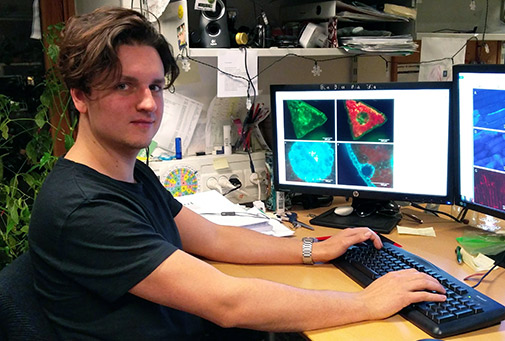PhD defence: Sebastian Nintemann
PhD Candidate
Sebastian Nintemann
Title of PhD Thesis
The spatial organization of glucosinolate biosynthesis - Localization of biosynthetic enzymes from the whole plant to the subcellular level
Abstract
Plants interact with their environment through numerous chemical compounds and because plants are the primary producers of biomass in many ecosystems, a large number of these compounds serve as chemical defenses against herbivores and pathogens. Defense compounds have vast consequences for plant resistance and nutritional value and many plant specialized metabolites are of high value due to their health promoting characteristics.
Glucosinolates are defense compounds found in many crops from the Brassicaceae family and are of high interest because of their nutritional and antinutritional properties in human and animal food sources. The glucosinolate defense system belongs to the best-studied pathways in plant specialized metabolism and the steps involved in their biosynthesis are known, their action as defense compounds is well understood and glucosinolate transport proteins have been identified. However, questions concerning the spatial arrangement of the glucosinolate biosynthetic machinery and the consequential distribution of the metabolites remain. Different types of glucosinolates require specialized enzymes for certain steps in their biosynthetic pathways and whether these act in the same cells is an open question. Likewise, it is not known how glucosinolate biosynthesis is orchestrated at the subcellular level.
These open questions were addressed with several approaches in this project, with the aim of shedding light on the spatial organization of glucosinolate biosynthesis from the whole plant to the subcellular level. Fluorophore-tagged versions of key biosynthetic enzymes from the two main branches of glucosinolate biosynthesis were analyzed in Arabidopsis thaliana. The cellular localization of these enzymes in the plant vasculature revealed previously unknown differences between the individual classes of glucosinolates under constitutive and induced conditions and identified the source tissues of these defense compounds. Protein-protein interaction studies were carried out to investigate the subcellular organization of glucosinolate biosynthesis. We identified a family of novel interacting proteins which might help to explain how these pathways are embedded in the cellular environment and linked to defense signaling.
Supervisors
Professor Barbara Ann Halkier
Associate Professor Meike Burow
Assessment Committee
Professor Sarah O'Connor, John Innes Institute, UK
Professor Yrjö Helariutta, The Sainsbury Laboratory, Cambridge, UK
Associate Professor Kirsten Jørgensen, University of Copenhagen (Chair)
Reception
The defence will be followed by a reception in room M117, Thorvaldsensvej 40, 1st floor, 1871 Frederiksberg

